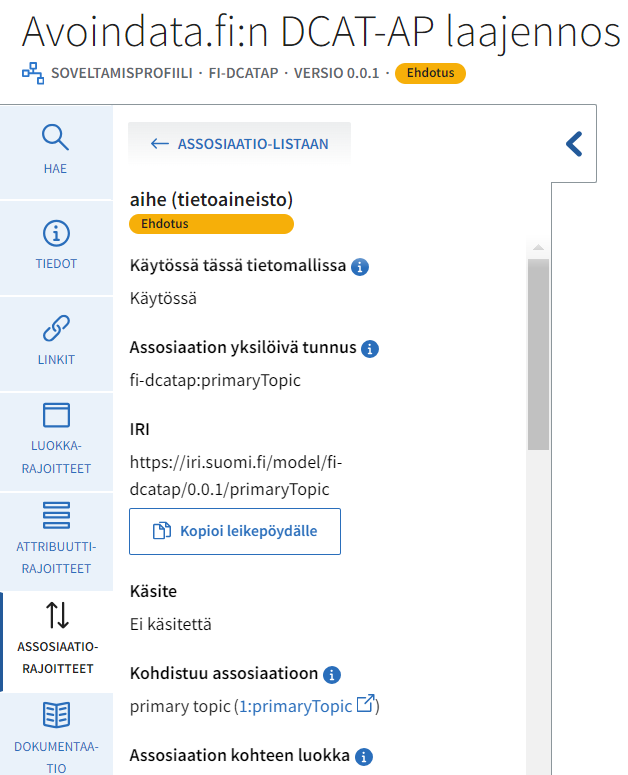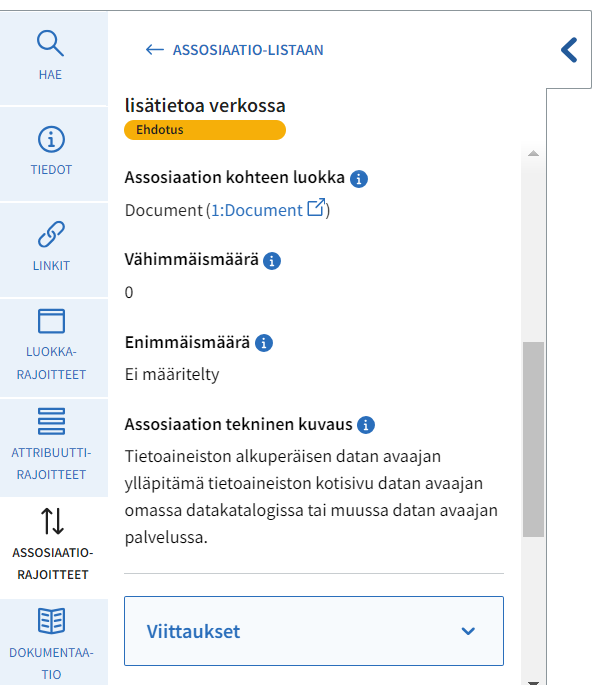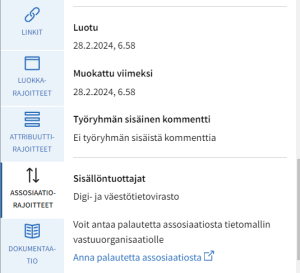The tool lists to the Association restrictions tab the number of association restrictions as well as the list of association restrictions that are utilised in the data model.
Click the title of the association restriction to open more specific details of the association restriction, for example:
- Name of the association restriction
- Icon that shows the status of the data model
- In use in this data model
- A switch that indicates if the resource that is generated from a data vocabulary must be used in this class. If the value is In use, the resource is shown in the technical schemes (JSON etc.), in the visualisation of the data model and it is used in class validation.
- Association’s identifier
- Identifier for the association restriction in the Data Vocabularies Tool.
- The long identifier, IRI-address: IRI-address is a unique address for the association restriction on the internet.
- With the IRI-address the association restriction can be used as a reference also outside of the Data Vocabularies Tool, for example in machine-readable interfaces.
- Click Copy to clipboard -button to copy the IRI-address to the clipboard of your computer.
- Concept: The link to the concept in the Terminologies Tool if the link has been added.
- Target association
- Reference to the association in the core vocabulary that forms the basis of the association restriction in this data model.
- Association target’s class
- The class that acts as the target of an association which creates a semantical relation between these two classes.
- Minimum count
- Cardinality restriction indicating the minimum count of values of an attribute. For example, 0 indicates that the value is optional, and it is not necessarily needed; 1 indicates that there must be at least one value; The value can be an integer.
- Maximum count:
- Cardinality restriction indicating the maximum count of values of an attribute. For example, 1 when only one value is allowed. The value can be an integer. If no maximum number is specified, the tool automatically interprets it as "infinite" and displays * in the visualisation.
- Association’s note
- Short textual description of the association restriction and for example its use case.
- References -drop-down menu shows a list of the resources, that have used this association restriction.
- Created: The date and time the association restriction was created. The users of the contributor organisation can also see the name of the person who created the association.
- Last modified at: The date and time the attribute restriction was last updated.
- Work group comment:Comments and instructions for other users editing the information content of the association restriction. This field is not publicly available.
- Contributors: Organisation(s) who owns the content and maintains it in the Data Vocabularies Tool.
If you want to give feedback to the contributor organization, click Give feedback on the association link. The Data Vocabularies Tool will open a link to your email, the email of the contributor organisation already given in the recipient field.
If you have editing rights to the tool, you can see Action -menu in the data models of your organization. You can then edit a selected association restriction or its prefix. You can also delete the association restriction
Työkalu listaa Assosiaatiorajoitteet-sivulle tietomalliin sisältyvät assosiaatiorajoitteet aakkosjärjestyksessä ja niiden lukumäärän.
Klikkaa haluamasi assosiaation otsikkoa, niin saat näkyvillesi kyseisen assosiaation tarkemmat tiedot, kuten:
- Assosiaatiorajoitteen nimi
- Tietomallin tilan ilmaiseva ikoni
- Käytössä tässä tietomallissa
- Kytkin, joka ilmaisee, onko tämän ydintietomallista perityn ominaisuuden pakko esiintyä tässä luokassa. Jos valinta on Käytössä, ominaisuus näkyy teknisissä skeemoissa (kuten JSON), tietomallin kaaviokuvassa ja sitä käytetään luokan validoinnissa.
- Assosiaatiorajoitteen yksilöivä tunnus Tietomallit-työkalussa
- Assosiaatiorajoitteen pitkä tunnus eli IRI-osoite, joka yksilöi assosiaation koko internetissä
- IRI-osoitteella assosiaatiorajoitteeseenn voidaan viitata myös Tietomallit-työkalun ulkopuolelta esimerkiksi konelukuisissa rajapinnoissa.
- Klikkaa Kopioi leikepöydälle -painiketta, niin työkalu kopioi IRI-osoitteen työasemasi leikepöydälle
- Käsite eli linkki Sanastot-työkalussa olevaan käsitteeseen, jos linkitys on tehty.
- Kohdistuu assosiaatioon
- Ydintietomallin assosiaatio, jota käytetään tämän assosiaatiorajoitteen kuvauksen pohjana.
- Assosiaatiorajoitteen kohteen luokka
- Luokka eli kohde, johon assosiaatio linkittää tämän luokan eli luo näiden kahden luokan välisen yhteyden.
...
- Ilmaisee, mikä on ominaisuuden arvojen vähimmäismäärä (kardinaliteetti). Esimerkiksi 0, kun arvo on valinnainen eli sitä ei välttämättä tarvita; 1, kun arvoja pitää olla ainakin yksi; arvo voi olla kokonaisluku.
...
- Ilmaisee, mikä on ominaisuuden arvojen enimmäismäärä (kardinaliteetti). Esimerkiksi 1, kun arvoja voi olla vain yksi; arvo voi olla kokonaisluku. Jos enimmäismäärää ei ole annettu, työkalu tulkitsee sen olevan ääretön ja näyttää visualisoinnissa *-tähden.
...
- Kuvaus resurssin sisällöstä tai ominaisuuksista, jotka resurssia hyödyntävän on tarpeen tietää. Esimerkiksi käyttötarkoitus tai muu tieto, joka ei ilmene assosiaatiorajoitteeseen linkitetyn sanaston käsitteen määritelmästä.
...
- Luotu Ajankohta, jolloin assosiaatiorajoite on luotu. Oman organisaation jäsenille näkyy myös, kuka assosiaation on luonut.
Muokattu viimeksi Ajankohta, jolloin assosiaatiorajoitteen tietoja on viimeksi muutettu.
Työryhmän sisäinen kommentti Kommentteja ja ohjeita muille assosiaatiorajoitetta muokkaaville henkilöille. Tämän kentän sisältö ei näy oman organisaation ulkopuolisille henkilöille.
- Sisällöntuottajat Yksi tai useampi organisaatio, joka omistaa aineiston ja ylläpitää sitä Tietomallit-työkalussa.
- Jos haluat antaa sisällöntuottajalle palautetta assosiaatiorajoitteen määrittelyistä, klikkaa Anna palautetta assosiaatiosta-linkkiä. Tietomallit-työkalu avaa sähköpostisi niin, että sisällöntuottajan sähköpostiosoite on valmiiksi viestin vastaanottaja-kentässä.
Jos sinulla on tietomallintajan muokkausoikeudet työkaluun, näet oman organisaatiosi tietomalleissa Toiminnot-valikon ja siinä muokkaustoimintoja. Voit muokata valittua assosiaatiorajoitetta tai sen tunnusta. Voit myös poistaa assosiaatiorajoitteen.


